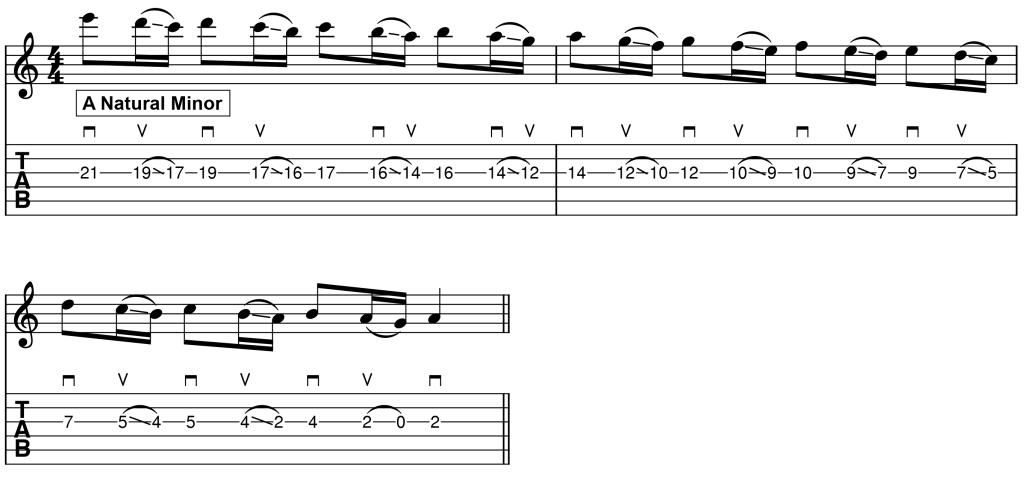In this guitar lesson we’ll be taking a look at a few ways to help you get better at playing guitar scales on a single string. But before we do that, we should quickly look at why I think single string scales are essential to getting an excellent command of guitar scales…
Some Benefits Of Practising Single String Guitar Scales
Learning guitar scales on a single string is one of my favourite ways to learn scales—in fact, if I could only use one method of learning scales, then I’d probably choose single string scales.
Some of the benefits that you’ll notice when you practice single string scales regularly include…
- You’ll start to think of scales as groups of notes and scale degrees rather than just fingering patterns.
- Your scale knowledge will improve drastically.
- Your overall fretboard knowledge will improve.
- Your ability to play by ear will improve.
- You’ll bust out of those over-used scale patterns.
- Your ability to shift positions will improve.
- Your ability to comprehend and absorb music theory will increase.
- You ability to move melodic motifs (ideas) through a scale will increase.
I hope some of the above benefits excite you! I can honestly say that working on scales on a single string was one of the best things that I did to improve my lead guitar playing—yes, I know, I’m starting to sound like an infomercial. 🙂
Here are a couple of other guitarists that acknowledge the power of single string scales…
“It boils down to this: a lot of guitarists today know about position playing, but very few know about playing up and down one string. Not surprisingly (at least to me) some of those few who do know are among the very best guitarists on the planet these days”.
Mick Goodrick (Author of The Advancing Guitarist)
“Changing the way you think about music can help you get out of old habits and break new ground. For the modern guitarist, one-string scales are a must”.
Joe Satriani (Guitar Virtuoso)
Now that we’ve talked a little bit about the benefits of practising single string scales, let’s now get started with the tips…
Practice Tip One: Memorise The Scale Degree Numbers
To illustrate this tip, we’ll be playing the A Natural Minor scale on the G-string. So let’s first look at what notes and scale degrees the A Natural Minor scale uses…

As you can see from the table above, the scale degrees are shown in the first row. I should also mention here that if you don’t understand what the numbers mean, then I recommend checking out the following two lessons before reading further…
OK, let’s now take a look at how I would go about memorising the scale degree numbers of the A Natural Minor scale on the G-string. Please check out the exercise below…
Scale Degree Memorisation Exercise

Below is an audio of me playing the scale degree memorisation exercise. To make the guitar easier to hear, I didn’t record my voice. But when you do the exercise yourself, be sure to say the scale degree numbers out aloud as you play each note. (See below for the full instructions).
Here’s exactly how I recommend practising this exercise…
- Play each note shown in the TAB. Use only one finger of your fretting hand.
- As you play each note say the scale degree number out aloud. (I have written what to say above each note of the TAB).
- Move from one note to the next very slowly in a relaxed manner. Before you play each note, try to imagine what it’s going to sound like.
- Repeat this process for five minutes.
Here are a couple of important points about the exercise…
- We’re starting on the lowest-sounding possible scale degree on the G-string, which is the b7.
- I’ve only gone up to the 21st fret because not everyone reading this lesson will have a guitar with 22 or 24 frets. If you happen to have more than 21 frets, then it would be a really good idea to extend the exercise as far as you can go.
Practice Tip Two: Learn To Play Melodic Patterns With The Scale
Although the first practice tip we looked at is a great start to learning the scale, it’s not going to do much to improve your guitar technique. Because of this, the second practice tip is more technique oriented.
With any guitar scale that I learn on a single string, I like to practice it using various melodic patterns. Let’s take a look at a couple of example exercises, so that you can see what I mean by this…
Melodic Pattern Exercise One
This exercise is ascending up the string using a six note melodic pattern. It is played using alternate picking, starting with a downstroke and is a great exercise to practice to improve the synchronization between both your hands.

Here’s the exercise being played at 60 BPM…
And here’s the exercise being played a bit faster at 120 BPM…
Melodic Pattern Exercise Two
This exercise is an example of a descending melodic pattern. It uses a three note melodic pattern that is played in the following way…
- Play the first note with a downstroke.
- Play the second note with an upstroke.
- Slide from the second note to the third note without picking.
One thing to watch out for, is that the last repetition of the melodic pattern uses a pull-off rather than a slide. (Look at the last four notes of the exercises to see what I mean).

Here’s the second exercise being played at 60 BPM…
And finally, here’s the same exercise being played at 120 BPM…
Practice Tip Three: Spend Some Time Improvising On A Single String
Now that we’ve looked at a couple of melodic pattern exercises, it’s now time to put the scale to use…
To do this I recommend going to YouTube and finding a backing track that’s in the key of A minor. If you don’t have any favourite places on YouTube, I tend to use backing tracks from these two channels…
If you excuse the shameless self-promotion, I should mention now that I’ve got a very small YouTube channel that I occasionally upload backing tracks to…
Once you’ve found a backing track that you like, it’s now time to improvise over it. Because we’ve been focusing on the G-string, the goal for this lesson is to only improvise on only the G-string.
Soloing on a single string can be quite a challenging thing to do, especially if you’re new to it. This is because many of the guitar licks and ideas that people learn generally use notes on multiple strings. So this means that you can’t play any of those multiple string licks and ideas during the single string improvisation—you’re probably going to feel very limited in what you can do! 🙂
Of course, the solution is to keep on working on your single string scales, using the three tips that I’ve mentioned in this lesson. If you make single string practice part of your weekly practice regime, you’ll soon become very comfortable with improvising on a single string.
Putting It All Together
OK, so we’ve just looked at three tips to help you to gain mastery of single string scales. Now I thought it would be helpful to describe how I would put it all together into a typical practice session…
Let’s say that I wanted to do some single string scale practice for 30-minutes, the first thing I would do is…
- Decide on what scale I want to practice and what string I will focus on for the practice session.
Once I’ve done this, then I would follow this structure for my practice…
Example Practice Session
- 5-minutes: Memorising the scale degree numbers.
- 20-minutes: Practising melodic patterns. (Usually I would practice one or two melodic patterns during this time).
- 5-minutes: Improvising over a backing track.
Simple huh? Of course, feel free to adjust the structure to your preferences and goals.
A Few Last Words
That’s all for this lesson, hope you enjoyed it. 🙂
If improving your fretboard knowledge and improvisation is important to you, then I recommend adding single string scales to your weekly practice schedule asap—it will help you a lot!
Are You An Auckland Guitarist That Wants To Significantly Improve Your Electric Guitar Playing?
 If you're an Auckland guitarist wanting to improve your guitar playing, then my Auckland electric guitar lessons might be for you. I can help you to the develop technique, musicianship and mindset that will move you closer to how you truly want to play.
If you're an Auckland guitarist wanting to improve your guitar playing, then my Auckland electric guitar lessons might be for you. I can help you to the develop technique, musicianship and mindset that will move you closer to how you truly want to play.
To find out more about exactly how I can help you improve your playing, then download my latest Auckland guitar lessons info pack below...
